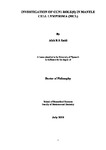INVESTIGATION OF CCN1 ROLE(S) IN MANTLE CELL LYMPHOMA (MCL)
| dc.contributor.supervisor | McCallum, Lynn | |
| dc.contributor.author | Zaidi, Afak R S | |
| dc.contributor.other | Faculty of Health | en_US |
| dc.date.accessioned | 2019-09-16T09:57:51Z | |
| dc.date.available | 2019-09-16T09:57:51Z | |
| dc.date.issued | 2019 | |
| dc.identifier | 10441056 | en_US |
| dc.identifier.uri | http://hdl.handle.net/10026.1/14917 | |
| dc.description.abstract |
Mantle Cell Lymphoma (MCL) is a comparatively rare non-Hodgkin`s lymphoma which is characterised by the overexpression of cyclin D1. Many patients present with or progress to advanced stage disease within three years. Disease progression involves down regulation of cyclin D1. Moreover, MCL is broadly considered as an incurable disease with median survival of patients being 3-4 years. CCN1, a matricellular protein involved in stem cell signalling within the haematopoietic microenvironment is highly expressed in early stage MCL cells and down-regulated in advanced stage disease. We have used the human MCL cell lines REC1<G519<JVM2 as a model for disease aggression. We have investigated the role(s) of CCN1, cyclin D1 and cyclin dependent kinase inhibitors in MCL progression. CCN1 dysregulation is identified in MCL progression whereby the magnitude of CCN1 expression in human MCL cells is REC1˃G519˃JVM2 cells by RQ-PCR, depicting a decrease in CCN1 expression with disease progression. Further investigation of CCN1 protein expression by western blotting showed that whilst expression of full–length CCN1 (42kDa) barely altered through the cell lines, expression of the truncated form (20kDa) was high in REC1 cells (OD:1.0) reduced in G519 cells (OD:0.5) and barely detected in JVM2 cells depicting decreased with disease progression. We have then demonstrated that cyclin D1 and cyclin dependent kinase inhibitors (p21CIP1and p27KIP1) are also involved in disease progression using the above MCL cell line model. Cyclin D1 was highly expressed in REC1 cells (OD: 1.0), reduced to one fifth in G519 cells (OD: 0.2) and not detected by western blotting in JVM2 cells. p27KIP1 followed a similar profile of expression as cyclin D1. Conversely, p21CIP1 was absent in the REC1 cells and showed increasing expression in G519 and JVM2 cells. Subcellular localization detected p21CIP1/ p27KIP1 primarily within the cytoplasm and absent from the nucleus, consistent with altered roles in treatment resistance. Mitochondrial detection of p21 in the JVM2 cell line supports an additional anti-apoptotic role. CCN1 likely plays a key role in B cell development; dysregulation of CCN1 may support MCL progression with p21CIP1 and p27kIP1 forming molecular signatures associated with progressive disease. REC1 cells and JVM2 cells were genetically modified using lentivirus to identify the potential pathways associated with CCN1. CCN1 knockdown was performed in REC1 cells (REC1 KD) and CCN1 overexpression in JVM2 cells (CCN1 OE). Proteomics analysis of JVM2 OE and REC1 KD revealed interesting results showing regulation of 44 proteins. 19 proteins regulated by CCN1 that simultaneously downregulated in the CCN1 KD model and up-regulated in CCN1 OE model. 25 proteins modulated by CCN1 that simultaneously up-regulated in CCN1 KD model and down-regulated in CCN1 OE model. Our results suggest novel roles for CCN1. Whilst CCN1 roles are substantial in solid tumour research, CCN1 role(s) within the haematopoietic compartment are less well defined or investigated. CCN1 may have potential role(s) as a novel pro-inflammation regulator by modulating macrophage migration inhibitory factor (MIF) and within regulation of haematopoiesis via pre-B cell colony enhancing factor (PBEF1). CCN1 was shown to modulate calcium ion signalling by targeting intracellular calcium receptor protein Calmodulin 3 (CALM 3). CCN1 altered Apolipoprotein M (ApoM) and Talin 1 (TLN1) expression and could potentiate new targets to supplement treatment for MCL. However, these novel pathways would need further investigation to identify the role(s) of CCN1 in B cell development and within the bone marrow microenvironment where regulation of haematopoiesis ensues. | en_US |
| dc.description.sponsorship | Iraqi Ministry of Higher Education and Scientific Research | en_US |
| dc.language.iso | en | |
| dc.publisher | University of Plymouth | |
| dc.rights | CC0 1.0 Universal | * |
| dc.rights.uri | http://creativecommons.org/publicdomain/zero/1.0/ | * |
| dc.subject | Cyclin D1 | |
| dc.subject | CCN1 | |
| dc.subject | p21 | |
| dc.subject | p27 | |
| dc.subject | Haematopoietic Microenvironment | |
| dc.subject | Full-length CCN | |
| dc.subject | Truncated form | |
| dc.subject | REC1 KD | |
| dc.subject | JVM2 OE | |
| dc.subject | Proteomics | |
| dc.subject | Macrophage migration inhibitory factor (MIF) | |
| dc.subject | Pre-B cell colony enhancing factor (PBEF1) | |
| dc.subject | Calmodulin 3 (CALM3) | |
| dc.subject | Apolipoprotein M (ApoM) | |
| dc.subject | Talin 1 (TLN1) | |
| dc.subject | Mantle cell lymphoma (MCL) | en_US |
| dc.subject.classification | PhD | en_US |
| dc.title | INVESTIGATION OF CCN1 ROLE(S) IN MANTLE CELL LYMPHOMA (MCL) | en_US |
| dc.type | Thesis | |
| plymouth.version | publishable | en_US |
| dc.identifier.doi | http://dx.doi.org/10.24382/528 | |
| dc.rights.embargoperiod | No embargo | en_US |
| dc.type.qualification | Doctorate | en_US |
| rioxxterms.version | NA |
Files in this item
This item appears in the following Collection(s)
-
01 Research Theses Main Collection
Research Theses Main



